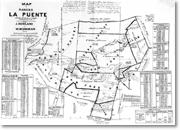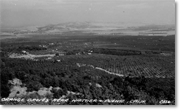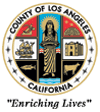How do I...?
Community History |
Frequently Asked Questions |
Local History Materials |
Image Gallery
Community Links |
Library History |
Community Profile
 La Puente Valley is a region of
eastern Los Angeles County originally inhabited by Gabrielino Indians until
1769, when Spanish soldier and explorer Don Gaspar de Portola and his
expedition arrived in the area, then lush with oak and alder trees, blackberry
bushes, and grapes. According to legend, Portola named the region "Llana de
la Puente" - meaning "Plain of the Bridge" - after making a bridge of poles so his
party could cross San Jose Creek. Two years later the San Gabriel Mission was
established as the first European settlement, and with its fertile soil, ample
water, and abundant Native American population for a labor force, the mission
soon became the richest in California. Following Mexico's 1822 independence
from Spain, however, the San Gabriel and other missions were secularized
starting in the 1830s, their properties sold or given away by a Mexican
government eager to profit from the missions' wealth.
La Puente Valley is a region of
eastern Los Angeles County originally inhabited by Gabrielino Indians until
1769, when Spanish soldier and explorer Don Gaspar de Portola and his
expedition arrived in the area, then lush with oak and alder trees, blackberry
bushes, and grapes. According to legend, Portola named the region "Llana de
la Puente" - meaning "Plain of the Bridge" - after making a bridge of poles so his
party could cross San Jose Creek. Two years later the San Gabriel Mission was
established as the first European settlement, and with its fertile soil, ample
water, and abundant Native American population for a labor force, the mission
soon became the richest in California. Following Mexico's 1822 independence
from Spain, however, the San Gabriel and other missions were secularized
starting in the 1830s, their properties sold or given away by a Mexican
government eager to profit from the missions' wealth.
 Drawn to California by such a splendid opportunity to acquire land, friends and
business partners John Rowland and William Workman led a wagon train of
settlers west from Taos, New Mexico, to Southern California, arriving in the
valley in November 1841. Within months they had petitioned for and received
preliminary title - finalized in 1845 - to the Rancho La Puente, a 48,790-acre
tract that formerly belonged to the San Gabriel Mission. The ranch extended
from the hills of what is now Hacienda Heights to San Bernardino Road in Covina,
and from the San Gabriel River to Walnut and Pomona; and it encompassed what is
now Baldwin Park, Charter Oak, Covina, La Puente, West Covina, and much of the
Puente and San Jose hills. Rowland and Workman built adobe homes and
established a thriving agricultural community engaged in ranching and farming.
In 1851 they divided their property roughly in half, each continuing to work
his land, but following their deaths in the 1870s their respective parcels were
bought and subdivided by developers, who then started communities that included
La Puente and Hacienda Heights.
Drawn to California by such a splendid opportunity to acquire land, friends and
business partners John Rowland and William Workman led a wagon train of
settlers west from Taos, New Mexico, to Southern California, arriving in the
valley in November 1841. Within months they had petitioned for and received
preliminary title - finalized in 1845 - to the Rancho La Puente, a 48,790-acre
tract that formerly belonged to the San Gabriel Mission. The ranch extended
from the hills of what is now Hacienda Heights to San Bernardino Road in Covina,
and from the San Gabriel River to Walnut and Pomona; and it encompassed what is
now Baldwin Park, Charter Oak, Covina, La Puente, West Covina, and much of the
Puente and San Jose hills. Rowland and Workman built adobe homes and
established a thriving agricultural community engaged in ranching and farming.
In 1851 they divided their property roughly in half, each continuing to work
his land, but following their deaths in the 1870s their respective parcels were
bought and subdivided by developers, who then started communities that included
La Puente and Hacienda Heights.
La Puente Valley attracted numerous settlers during the 1840s with the Gold Rush and again in the 1870s with railroad lines. By the early twentieth century the region was known for its abundance of citrus, walnut, and avocado crops, and maintained its agricultural character - mixed with growing industrial development of oil, banking, and communications - through the middle of the twentieth century. After World War II, the region underwent a building boom that eventually edged out crops in favor of development, and today is mostly residential in nature. More information about the history of La Puente Valley can be found in the following sources:
Website Links:

Print Sources:
- Hacienda Heights: Growing with Pride. Ideas Unlimited, 1970.
- Nevins, John A. The Puente Area [microform]: A Study of Changing Agricultural Land Use. Los Angeles, CA: University of California, Los Angeles, 1951.
- Rowland, Leonore. Romance of La Puente Rancho. 1958.
- History of La Puente Valley, California. La Puente Journal, 1960.

Places to Visit:
-
La Puente Valley Historical Society
16021 E. Gale Avenue
City of Industry, CA 91745
(323) 336-7644
-
Workman and Temple Family Homestead Museum
15415 East Don Julian Road
City of Industry, CA 91745-1029
(626) 968-8492
Images:
- Aerial view of the Workman-Temple Homestead site from the northeast, 1940
[Courtesy of the Workman and Temple Family Homestead Museum] - Construction of Turnbull Canyon Road, c. 1915
[Courtesy of the Workman and Temple Family Homestead Museum] - Map showing partition of lands belonging to John Rowland and William Workman in the east San Gabriel Valley, 1868
[Courtesy of the La Puente Valley Historical Society] - Orange groves near Whittier and La Puente, c. 1940s
[Courtesy of Cecelia Wictor]
![]()
Agoura Hills |
Antelope Valley |
Carson |
Catalina Island |
Claremont |
East Los Angeles
Gardena |
Lakewood |
La Puente Valley |
Pico Rivera |
San Dimas |
San Fernando
San Gabriel |
South Gate |
Willowbrook





